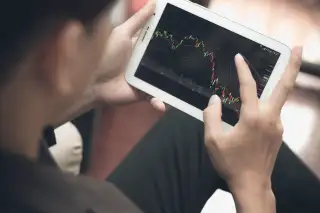Why Your Phone May Be Making You a Worse Investor

Americans reach for our phones an average of nearly 150 times a day, a radical shift from even a decade ago, and experts are only now getting a real handle on the implications for our psyches and behavior.
That we are easily distracted is clear. The habit has even given us a new ailment: “text neck,” pain in the neck and back caused by too much time staring at little screens. One of the things we are looking at more often than ever? Our portfolios. A survey by the Allianz Global Investors Center for Behavioral Finance found that more than one in five Americans are checking on their investments at least once a week. That frequency of monitoring may be affecting how we invest—for the worse.
The problem is our aversion to losing money. Put simply, we care more about avoiding a loss than we do about locking in a gain. So if we are able to see nearly every little dip in our portfolio’s value, however short lived, it can make us less willing to take on appropriate investment risk, according to research by Shlomo Benartzi, an accounting professor and co-chair of the Behavioral Decision Making Group at UCLA’s Anderson School of Management.
“When people get frequent updates on their portfolios, they increase the likelihood of getting news of a short-term loss,” he wrote. “Because these losses have an outsized impact on our behavior, frequent checking can lead us to abandon our long-term investing plans.’
Our aversion to loss was documented years ago by Paul Samuelson, a noted economist. He offered one of his colleagues a bet on a coin toss, stipulating that he would lose $100 if it came up tails but win $200 if it came up heads. The colleague refused, explaining that losing $100 would pain him more than winning $200 would give him pleasure.
But the colleague said he would be happy to take the bet for 100 coin tosses. His odds of wining money would be the same, but knowing the results after the completion of 100 coin tosses would be less stressful than hanging on the outcome of one.
The same principle can apply to your 401(k) account, according to Benartzi. Ten or 20 years ago, “most of our account updates arrived via paper statements issued on a quarterly or annual basis,” he wrote. “As a result, we were relatively insulated from ephemeral market swings. The digital age, however, has stripped away this insulation—investors are hyperaware of every market bump, swing and correction.”
That impulse to focus on the now impedes our ability to stay focused on our actual investment goals, which may be quite long term. Benartzi named that condition “myopic loss aversion,” because of the mismatch between our monitoring and our investment time horizon.
Financial institutions could do a lot to reduce myopic loss aversion, Benartzi proposed, chiefly by changing how they present information to their customers.
“If our financial statements show losses on the first page and we are supposed to ignore it, that’s easier said than done,” he said. “Framing things as projected over time does tend to make people think longer term.”
You could also try and redirect any jitters you have about investment performance toward a positive financial move. For example, if you check your account balance and it is down a little from the day before, take a minute and transfer some money from your checking account to savings, or put $5 in a piggy bank or penny jar. You could even tell yourself that the transfer is a “fee” you pay yourself for checking your balance too often.
There is also a very simple way to push back against loss aversion. As Mom would say, put down your phone, already. Someday that thing is just bound to cause you trouble.